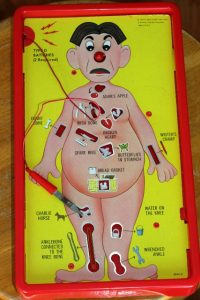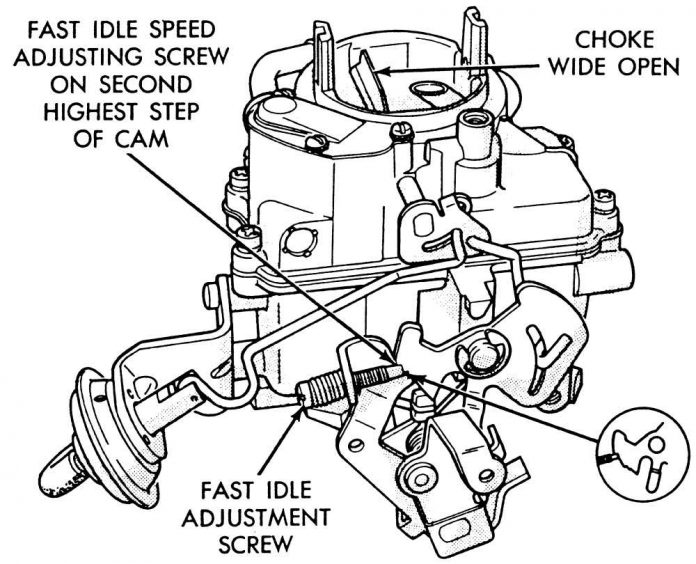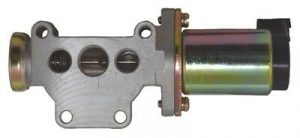Before there were computers in cars, all it took to adjust the engine idle speed was a screwdriver and five minutes or so.
You turned in – or out – a screw that moved the throttle arm on the side of the carburetor slightly forward or slightly back, the engine idle speed going up – or down – correspondingly.
Anyone could do it – and such minor initiations into vehicle maintenance/adjustment often led to braver and deeper forays. Adjusting the idle was perhaps the next thing a teenaged kid attempted after successfully performing an oil change.
Today, it takes a toolbox to adjust engine idle – and skills not-just-anyone has, especially people who’ve never learned to work on cars, like teenaged kids. Because how can they, when even the simplest thing is intimidatingly complicated to someone who hasn’t got skills – or the tools.
My ’02 Nissan Frontier pickup needed to have its idle adjusted – not because it was too high or too low, a problem easily remedied in the pre-computer days by the turning of a screw – but because its idle was surging erratically, something that you fix today by cleaning or replacing components such as the Idle Air Control (IAC) motor, a device that is both mechanical and electrical and which has to be removed – to be cleaned – or replaced, if cleaning doesn’t work – if you want the idle to stop fluctuating erratically.
This is no single screwdriver and five minutes job.
On my ’02 Nissan, the IAC is screwed to the side of the throttle body with four screws – two of them inaccessibly offset mounted such that you can just barely see them and the only way to get at them is by disconnecting several peripherals, including the connections to two in-the-way fuel injectors and a fuel return line and then at least unbolt the throttle body so as to be able to tip it back enough to get access to the IAC screws and then carefully unscrew these Phillips headed screws, which are made of typically Japanese soft alloy. If the screwdriver slips – or the + inset schmears, you’ll need to vise-grip or not-so-easy-out them out.
Two of the hex-head bolts that secure the TBI to the intake base are hard -to-get-at because of peripherals in the way. These have to carefully removed – which you can accomplish if you have a toolbox full of specialty items such as skinny extender bars and other improvised (i.e., ground down with a grinding wheel) sockets that can shimmy through the space you’ve got.
All while being careful not to drop anything into the now-open intake manifold – put a rag down there while you work!
It’s more of a PITAS for the experienced wrench than a technical challenge. But for someone without experience, the procedure might as well be a surgical procedure performed by someone who didn’t go to medical school.
Installation, once physically finished, isn’t the end of the job, either. Now you must go through a key on/key off conga ritual to get the IAC to “relearn” its job. In the case of my truck, this entails turning the ignition key on and waiting for precisely 2 seconds – you will need a stopwatch to be accurate – then off for 10, then on for 2 and off again for 10.
No, I am not making that up. And there are two other – similar – “relearn” protocols necessary to get the IAC and other related peripherals to remember how to do their jobs.
A job it used to take a screwdriver to adjust – and maybe five minutes. No disassembly required.
This job took me about 45 minutes and entailed disassembly.
Just one screenshot that helps explains why ordinary people – especially teenagers – working on cars has become so uncommon nowadays when it was once as common as checking the tires and the oil, two other formerly routine, once-simple things that aren’t anymore.
Some new cars don’t even have dipsticks. The computer checks the oil. And all cars built since the mid-2000s have tire pressure monitoring systems, chiefly the fallout of the ‘90s-era Ford Explorer/Firestone tire fiasco.
These TPS systems are not as reliable as using a stick because they are electronic. Sticks don’t glitch. Electronics do.
And you need more than just a screwdriver and five minutes to fix ’em!
. . . .
Got a question about cars, Libertarian politics – or anything else? Click on the “ask Eric” link and send ’em in!
If you like what you’ve found here please consider supporting EPautos.
We depend on you to keep the wheels turning!
Our donate button is here.
If you prefer not to use PayPal, our mailing address is:
EPautos
721 Hummingbird Lane SE
Copper Hill, VA 24079
PS: Get an EPautos magnet or sticker or coaster in return for a $20 or more one-time donation or a $10 or more monthly recurring donation. (Please be sure to tell us you want a magnet or sticker or coaster – and also, provide an address, so we know where to mail the thing!)
My eBook about car buying (new and used) is also available for your favorite price – free! Click here. If that fails, email me at [email protected] and I will send you a copy directly!













I drove a ’67 MGT B as my daily for a few years in the Pacific Northwest. Several times after work, the humidity had changed enough that I had to adjust the idle in the parking lot. The Teamsters would see me with my hood raised and come over to help the damsel, and I’m like, nah, I got this, keep a dime in my pocket for just this reason. Keeping the twin carbs synched, that was the fun bit. Looking forward to having her back on the road, with a dime for good measure.
Hi Marit,
Yup! Carbureted engines are like that; altitude/weather/fuel type can “adjust” idle (modern cars with computers and EFI self-adjust for those conditions). I’m one of those weirdos who actually enjoys making the adjustments 🙂
I had a 79 Ford F150 and didn’t pass the e check. I pulled out and went around and opened the hood. took off the air cleaner and leaned the carb and went through again and passed. When I pulled out I had to rich it up again or it would stall when idling.
I got a set of Vessel JIS screwdrivers years ago and haven’t stripped the head out of a Japanese phillips since,well worth the money spent in reduced aggravation.
Good analogy with the surgical procedure. I still need videos to do basically anything. Can’t just look at it and figure it out. Or remember procedures. Need step 1, 2, 3, 4, 5, then 5, 4, 3, 2, 1. The more steps, the more my brain hurts.
The problems you had are because you’re working on a Japanese vehicle designed to have been thrown away by now in the home market. Low duty JIS fasteners too well suck because they easily strip out or break. All your complaints here are typical of what I have working on Mazdas. Where things are a pain to accomplish often for saving a dime on assembly or just for the sake of being so.
On my 4.6L V8 Ford the IAC valve is right up on top held in by two hex head screws, 8mm socket needed if I remember correctly. Both are easily accessible. Once off, clean it, put it back on. Done. I’ve done it maybe 3 times over the last 24 years. Is it ess time than setting idle on a carb a couple times a year? Probably, especially if I consider doing it with instrumentation instead of by feel.
A woman I once worked with had the old pushrod ‘5.0’ in a big mercury. I told her what she needed to do. She had never done a car repair before. I did replace an alternator at work on her car and that’s what got her interest up. She replaced it on her own without me present at her home. (her decision to replace rather than clean, but it was a cheap part for that engine).
Hi Brent,
Yup! I replaced every cheesy Phillips screw fastener that held the cases of my ’76 Kz900 together with stainless-steel hex headed units. They look better – and no more ruining the + every time I try to get one of those cases off!
Phillips and JIS look alike, but they’re not.
If you get genuine JIS bits or drivers, you’ll have much better luck.
Yep, and good luck if the straightforward remove-clean-replace doesn’t fix the problem.
My 2018 Harley has an occasional high idle hang on a hot day. Mechanical? Computer program? Who knows?
Several issues make me think keeping the 04 Harley with carb would have better. The Mikuni carb even had adjust on the fly idle control, thumb wheel on a short cable attached to the screw. And the 04 no fuel pump – gravity never fails.
Hi Spark,
Yup – and this is why I love my ’03 ZRX1200 – the newest bike I own and the newest bike I will ever own. No gotverdammt computer; instead four entirely mechanical carburetors. Stuff you can touch and see – as opposed to code and bugs you have to divine!
Sorry to hear about your 18 Harley. I specifically bought my 2000 Dyna because it was the last year with the carburetor. I also wanted to say to Eric that one of the *best things* about a Harley is their usage of high quality fasteners throughout the entire motorcycle. Every on is stainless steel, and there are not any Phillips head screws! All hex head. Yes, my old Kawasaki was a pain with those damn Phillips screws. Didn’t know they had them on cars. I don’t remember my 95 Subaru having too many of them…